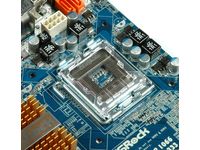Power-Saving Motherboards: Fact Or Fiction?
ASRock P45R2000-WiFi: No Special Power-Saving Feature

ASRock’s power-saving feature is called Intelligent Energy Saver (IES). It switches automatically from four phases to two-phase operation at low CPU loads or in idle. However, IES is available only on select motherboards, and the P45R2000-WiFi isn’t one of them. We decided to use this anyway as an example of an upper-mainstream desktop motherboard. It comes with a impressive number of interfaces, decent overclocking options, a wireless network module and support for either DDR2 or DDR3 memory.
Features & Interfaces
The P45R2000-WiFi is well-equipped: it has two x16 PCI Express slots, which you can switch to single x16 operation, or to dual x8 for AMD CrossFireX dual graphics. Two additional x1 PCIe slots will take your add-on cards. Three 32-bit PCI slots come in handy for legacy cards. HD audio is present on almost all motherboards today; ASRock’s implementation is specified to support a signal-to-noise ratio of 110 dB.
The P45R2000-WiFi is the only motherboard in this review that accepts either DDR2 or DDR3 memory, although it’s designed to accept just two DDR2 DIMMs but up to four DDR3 DIMMs. Two FireWire 1394a ports, two eSATA ports, six USB 2.0 ports and two Gigabit networking ports provide connectivity. The eSATA ports are shared with two connectors on the inside of the back panel.

Efficiency Features
This particular motherboard model does not support any hardware-assisted power-saving features, so it must rely on the efficiency of its four-phase voltage regulator for the processor, and individual circuits for the memory and chipset. However, it still does well, and it gives us a nice boost in per-Watt performance when using DDR3 memory instead of DDR2. Check our test results pages for details.




Stay On the Cutting Edge: Get the Tom's Hardware Newsletter
Get Tom's Hardware's best news and in-depth reviews, straight to your inbox.
Current page: ASRock P45R2000-WiFi: No Special Power-Saving Feature
Prev Page Efficiency Testing Basics Next Page Asus P5Q Deluxe: EPU Power-Saving